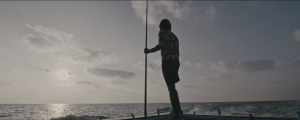INFOFISH, July 2022
Emilia Dyer, Philippine Wouters, Zacari Edwards
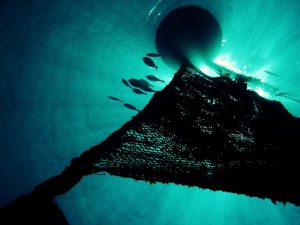
Plastic pollution has quickly become a global concern. This is particularly true in our oceans where plastic litters our coastlines, entangles endangered and protected animals and, when broken down to small enough pieces, is consumed and accumulates up the food chain all the way to humans. Recent evidence shows that ingesting plastic can result in reduced energy, have toxic effects on the body, and even behavioural changes in some species, so the plastic crisis directly affects us all. Around 14 million tons of plastic are disposed of at sea every year and the nature of plastic means that it can take decades, even centuries, to fully degrade. That means almost all of the plastic ever created still exists somewhere today, even in dynamic environments like the ocean.
When left at sea, plastics can drift for thousands of miles until they are removed. This means that, as well as spreading diseases and contributing to the invasion of alien species to an environment, they will regularly enter the waters of those who did not cause the pollution. Often, the burden of plastic pollution is felt by small island developing states (SIDs) whose waters have become increasingly plagued by plastic bottles, packaging and, more regularly than we often realise, abandoned, lost or discarded fishing gear.
We don’t talk about it enough, but fishing gears make up a significant amount of oceanic plastic and, worse still, are the most harmful for the marine environment. They can include anything from lost fishing nets and buoys, to drifting Fish Aggregating Devices (dFADs) which are intentionally left to drift at sea and attract marine life. When abandoned, lost or discarded at sea these gears become known as ‘ghost gear’ as they will drift aimlessly at sea, entrap unsuspecting animals and snag on sensitive habitats, even in protected areas, until removed. On their journeys they meaninglessly kill thousands of marine animals every year. For example, studies have estimated that as many as 960,000 silky sharks are killed every year in the netting associated with dFADs every year. This doesn’t account for other species of sharks, turtles, dolphins, seabirds or whales, let alone other types of fishing gear. Additionally, a 2016 study found that ocean plastics and ghost gear have contributed to the demise of 45% of threatened species on the IUCN Red List. Every year, more research finds similarly destructive implications of ghost gear at sea, and yet, vast amounts are still being lost.
Reports over recent decades have found these destructive gears to make up 10% of ocean plastic, which is currently estimated to equate to between 800,000-1.2 million tonnes annually. However, a 2018 report published in Nature Journal found that “86% of large, floating plastics [in the Great Pacific Garbage Patch] are fishing nets”. Later, in 2019, a report released by GreenPeace found that 85% of the plastic pollution on sea mounts, ocean ridges, and the sea floor is fishing equipment, and that bouys alone make up 58% of all large plastics floating on the ocean’s surface.
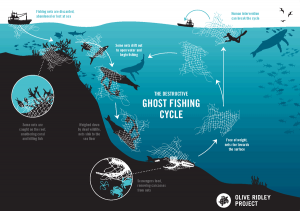
There’s little doubt that the fishing industry is a significant contributor of oceanic plastic pollution, but fishing methods vary greatly in their relative contributions. For example, pole-and-line fishing depends on the ability to consistently and quickly land tuna during short fishing events. Therefore, these fishers carefully choose the monofilament lines they will use based on the breaking resistance and their target species to ensure they are not regularly broken and lost during fishing events, the replacement time of which would otherwise compromise the profitability of the vessel. Whilst lines can still occasionally be lost, the breakage often occurs close to the hook so only a small amount of line is lost even when gear losses do happen. As these hooks are barbless, hooked fish can reject them relatively easily and the weight then causes the hook and line to sink to the ocean floor. This means that the minimal amount that is lost by pole-and-line fisheries is unlikely to become an ingestion risk to marine life and is also highly unlikely to pose an entanglement risk, even to small animals, as lengths of line are very short. The negligible contributions of the one-by-one fleets, which encompasses pole-and-line, handline and troll methods, have been evidenced by studies conducted by the Azores Fisheries Observer Program (POPA) of the Azores pole-and-line fleet. Their research found that the entire fleet only lost 0.5kg of fishing gear annually. Additionally, when lost, one-by-one gears do not have the same ecological consequences as floating nets and buoys. This is because a hook and line is unlikely to entrap an animal as it sinks to the seabed.
On the other hand, fishing methods which release gears to drift at sea unattended for any length of time, like drifting gillnets and dFADs, threaten the ocean ecosystem on a different scale. The thin netting of gillnets make these contraptions a particular risk to almost all ocean species as it is difficult to see them in the water. These types of nets are very slow to degrade and even though some studies estimate they will ghost fish for up to 3 months, others have found evidence that they can remain ghost fishing at sea for as long as 20 years! As a result, thousands of marine animals are entangled and killed in ghost nets each year. Some researchers estimate that 4.1 million small cetaceans have been ghost fished by gillnets in the Indian Ocean alone, between 1950 and 2016. dFADs, whilst easier to see in the water, present a similar risk to ocean life. Whilst these devices often have satellite buoys attached, in order for the deploying ship to find and fish them again, it is rare that they are responsibly removed. Research has found that, of the 121,000 dFADs deployed annually, 90% are never retrieved. After decades of plastic pollution and poor performance in terms of resolving the issue, as an industry, we need to take on a different approach to tackle the problem and protect the ocean.
Offsetting
The longevity of plastic’s lifespan and the scale of the problem means that reducing plastics is no longer enough and we need to take it a step further; we need to remove the decades of pollution which has accumulated at sea. It’s important that we now remove plastics at a faster pace than we are polluting the ocean, and do so at a greater scale than we currently are.
Parallels can be found across industries which have previously polluted or degraded environments. For example issues of carbon emissions, deforestation and biodiversity loss face the same mountain to climb. In a bid to reduce the negative impacts of various industries offsetting has risen to the forefront as a potential solution. We’ve all heard of offsetting. From carbon offset flights or fossil fuel offsets to toilet paper brands which plant trees, the idea has taken off in recent years. However, there is hardly any evidence of offsetting among the fishing industry at all, particularly in relation to ocean plastics, despite the fact that this industry is one of its greatest contributors.
Plastic Neutral Fisheries
Despite the slow progress in plastic reduction or offsetting among the industry, the scale of threat that plastic pollution from fisheries presents to ocean ecosystems means that the idea of a plastic neutral fishery has been increasingly talked about in some sectors as a way to show consumers that a fleet is environmentally sustainable. The concept is that a fleet would remove as much plastic from the ocean as it loses on an annual basis to have an overall neutral, or even positive, effect.
Despite their minimal gear loss contributions one-by-one fisheries across the world have acted as pioneers for ocean plastic offsetting programmes with the goal of becoming plastic neutral. The International Pole and Line Foundation (IPNLF) recognised this opportunity in the fisheries they work with and began to develop projects to test the feasibility of plastic neutrality in one-by-one fisheries. Now, pole-and-line fisheries in the Maldives and the Azores are leading the way and have set a new standard for what it means to successfully reduce and offset their ocean plastic contributions. This new approach is replicable and therefore, it can, and should, be adopted by other areas of the fishing industry.
Maldives Ghost Gear Collection Programme
In 2020, IPNLF developed a pilot ghost gear collection project in the Maldives with the Olive Ridley Project (ORP), funded by World Animal Protection’s Joanna Toole Ghost Gear Solutions award. The Maldives host a diverse array of marine species but are increasingly threatened by ghost gear. Commercial net fishing is illegal in Maldivian waters and the national fleet uses only environmentally sustainable pole-and-line and handline fishing methods. Nevertheless, ghost gear, lost, abandoned or discarded by foreign fleets operating elsewhere in the Indian Ocean drifts into their waters and puts their wildlife in danger by killing marine species, like turtles and sharks, and inflicting damage on critical habitats, like coral reefs and seagrass beds.
Twelve vessels from Gemanafushi Island took part in the project which built on the relationships IPNLF has formed with one-by-one Maldivian fishers and incentivised them to collect ghost nets they encountered during their fishing trips. This at-sea collection model meant that the ghost fishing cycle of nets was drastically curtailed in comparison to collecting beached nets and less damage could be done to the ecosystem.
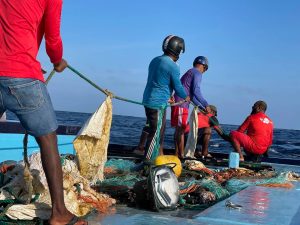 During ghost gear collection, fishers were to note the location of collection and bring ghost gear aboard to be dismantled or stored before being taken back to shore. Back on land, ghost gear was weighed, recorded and then either responsibly recycled, or distributed among the community to be upcycled.
During ghost gear collection, fishers were to note the location of collection and bring ghost gear aboard to be dismantled or stored before being taken back to shore. Back on land, ghost gear was weighed, recorded and then either responsibly recycled, or distributed among the community to be upcycled.
The fundamental aim of this project was to explore the feasibility of developing a plastic neutral one-by-one fishery in order to set a new standard for what is considered best performance in the sector. By the end of the project, these one-by-one tuna fishers from 12 small vessels in Gemanafushi Island collected enough ghost nets to offset the total weight of all gear loss contributions of half of the national Maldivian fleet (almost 350 Maldivian vessels).
It was clear from these achievements that there was promising potential to develop plastic neutral one-by-one fisheries in the Maldives and the project formed a replicable model which could, in time, be used in other fisheries around the world.
Azores Ghost Gear Collection Competition
On the other side of the world, IPNLF also developed a Plastic Neutrality Competition in the Azores, jointly supported by Biocoop and Fish4Ever.
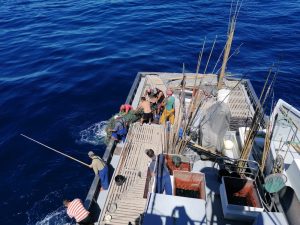
Photo: (c) Azores Fisheries Observer Program (POPA)
The Azores’ waters are a hotspot for cetaceans and a number of environmentally threatened species, such as blue whales and whale sharks. However, their location, at the edge of the North Atlantic subtropical gyre, puts these beautifully unique islands and diverse waters within a retention zone for floating ocean plastic. The majority of pollution that floats into their waters is fishing gear that has been lost or abandoned by foreign vessels fishing elsewhere in the Atlantic Ocean. The Azores fishing fleet, on the other hand, is largely made up of small vessels and, in terms of tuna fishing, use largely pole-and-line methods.
In order to obtain plastic neutral status, IPNLF, in partnership with Azores Ocean Observatory (OMA), Azores Fisheries Observer Program (POPA), Associação de Produtores de Atum e Similares dos Açores (APASA), Federação das Pescas dos Açores (FPA) and the Institute of Marine Research (IMAR), developed a ghost gear retrieval competition to be held among the Azores pole-and-line fleet. The project incentivised fishers by putting them in competition with the plastic contributions of the entire fleet, to remove more in 3 months than they had collectively lost throughout the year, and in competition with the other vessels to remove the most as an individual vessel.
POPA collected data on the fishing gear loss rates of the pole-and-line fleet from 2019 until 2021. The data showed that the entire one-by-one fleet only produces 0.5 kg of fishing gear related litter on an annual basis. IPNLF calculated that, with such little contribution, it would take the entire Azores pole-and-line fleet approximately 1000 years to lose the same weight of plastic as a single industrial purse seine net. This puts the disparities between the two gears into perspective. Based on the above, and results of past competitions, IPNLF anticipated that the competition would result in at least 100kg of ghost gear being retrieved, and that the Azores fleet would attain “plastic neutral” status.
7 vessels of the APASA pole-and-line fleet took part in the 3-month competition from June to September 2021. The vessels were advised to collect marine litter that they encountered on fishing trips, with a focus on removing ghost gear. The weight and type of collected debris was recorded by onboard POPA observers who evidenced collections with photographs. Once weighed and recorded, the collected ghost gear was disposed of responsibly through Lotaçor; an Azorean, public owned organisation that supports the fishing sector.
Throughout the 2021 competition, these 7 vessels of the APASA fleet removed 452.1 kg of marine plastic litter. 437.6 kg of this was ghost gear in the form of buoys, nylon cables and multifilament nets. This means that, in 3 months, these vessels retrieved 875 times more ghost gear in weight than they lost annually in their own fishing operations. These achievements by the Azores fleet far surpass plastic neutrality.
Future Opportunities
These two ground-breaking, successful projects, from very different island communities, demonstrate the scope of opportunity that one-by-one tuna fishing fleets have to contribute to the solution on plastic pollution.
Only nineteen vessels have taken part in these projects in total so far but, with more than 2 million small-scale fishing vessels worldwide, there is great potential to replicate and upscale these projects elsewhere. The success of these projects was determined by the strong engagement from fishers, which was driven by incentives, a sense of community, and, indeed, a healthy dose of competition.
So far, the best performance among the fishing industry in terms of plastics has been very weak. Some fisheries management organisations encourage fleets to remove dFADs from the water and encourage the responsible disposal of single use plastics but until now, no fleet had come close to achieving and evidencing plastic neutrality. These projects raise the bar of expectations and set a new standard for what we can achieve at sea. Whilst the nature of one-by-one tuna fishing offers a strong foundation for these projects, IPNLF hopes that this can be replicated among other gear types and, in time, achieving plastic neutrality can become the new standard within the fishing industry.
In order to really tackle the plastic crisis, however, the fishing sector must do both – they need to reduce their plastic pollution contributions and put processes in place to facilitate the removal of plastics from the ocean during their fishing operations, to work towards plastic neutrality. It’s important that the two go together as offsetting should not be there to support business-as-usual, it should be used to compensate for pollution which cannot be avoided.
As plastic pollution threatens the future of our marine life and ocean ecosystem, it is in the best interest of the fishing industry to resolve the crisis that is coming to the surface. The results from the plastic neutrality projects in the Maldives and the Azores show that a plastic neutral tuna fishing industry is entirely attainable for at least a section of the industry. We should embrace and harness the potential of these achievements to help restore oceanic biodiversity to ensure a healthy, functioning ocean for generations to come. If the fishing industry can contribute to the clean-up of the oceans then it can ensure the longevity of the resources it relies so heavily upon.
Additionally, ocean plastics are a key issue of concern for consumers when it comes to sustainable seafood, second only in recent years to climate change. Moving forwards, it has been demonstrated that one-by-one tuna fisheries can far surpass plastic neutrality and this will either evolve into a new standard for the sector as a whole, or one-by-one plastic neutral tuna will be uplifted as a premium. Plastic neutrality is an opportunity for the fishing industry to build trust with its consumers and, therefore, it’s important, from a business perspective, that the industry is able to meet the standards of its customers.
The plastic pollution crisis has a firm grip on our oceans and we must all contribute what we can to its clean-up and to prevent the enormous gear loss by certain fisheries. As we move to loosen its hold, we must first be aware of the scale of the issue and the greatest sources of pollution. We need to talk more about the contributions of the fishing industry, as well as the potential solutions they could offer as an industry that operates on the water. At the moment, companies and fisheries are praised for having mitigation strategies in place, even if that means they are still contributing to the problem, only to a lesser extent. It’s time for the industry to move towards a place where all vessels collect more plastic than they lose. It is vital, then, that the industry is supported as they move to turn things around through plastic reduction and removal, to achieve plastic neutrality. One-by-one fishers are proving that this is possible and hopefully the rest of the fishing industry will be able to follow suit.
We need to look at the fishing industry differently. The one-by-one fleets of the Maldives and the Azores have shown themselves to be unexpected allies of the ocean. They have demonstrated great success in achieving plastic neutrality through innovative ideas and now it is time for the rest of the fishing industry to pursue the same goals. The health of the ocean affects us all and we are all responsible so now that we know a plastic neutral tuna fishing industry is possible, we shouldn’t take a neutral stance on its potential.
